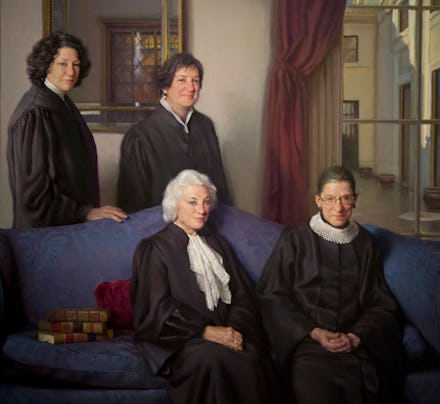How to Get a Gigantic Painting of Yourself in the National Portrait Gallery

Nelson Shanks unveiled his new portrait of the female Supreme Court Justices to the press last week. The painting, called "The Four Justices," is an enormous 9-feet-6-inches by 7-feet-9-inches canvas that will hang at the Smithsonian’s National Portrait Gallery in Washington, D.C.
While some bloggers have commented on the painting’s idiosyncrasies, what stands out to me is the content. The painting reminded me that to this day, only four women have presided on the U.S. Supreme Court. As a feminist and a millennial, the many lessons of their careers inspire me.
Here are just four:
1. Sometimes, it's good to dissent
Ruth Bader Ginsburg made famous the phrase, "I dissent," omitting the traditional adverb, "respectfully," in the landmark case that decided our president, Bush v. Gore.
Sandra Day O’Connor has pissed off both sides of the aisle in cases such as Roe v. Wade. Change doesn't happen if you don’t ruffle some feathers.
2. Support human rights
Although traditionally conservative, Sandra Day O’Connor was the deciding factor on Roe v. Wade. O’Connor gave the vote needed to uphold the court’s earlier decision on abortion rights, despite the Republican call to reverse Roe v. Wade.
Ruth Bader Ginsburg was the first justice to officiate a same-sex wedding. Day O’Connor officiated the first same-sex wedding to take place in the Supreme Court’s halls. Despite their political affiliations, these fabulous four have tended to put politics aside when it comes to civil rights and true equality.
3. Be willing to change
In a country obsessed with partisanship, it is a relief to know there are influential people who are willing to look at new information, and change their opinion accordingly.
Sandra Day O’Connor was well known for her conservative agenda. However, belonging to the Republican party didn’t stop her from being open to change her opinions on hot button issues, such as gay rights and abortion laws. While mainstream media might force this binary of red versus blue down our throat, following O’Connor’s lead to work across the aisle could do our other leaders a world of good.
4. Go hard
While Sandra Day O’Connor paved the way by being the first female to be appointed to the United States Supreme Court, each one of these justices have broken one glass ceiling or another.
In addition to being the second female appointed to the court, Ruth Bader Ginsburg became the first female tenured professor at Columbia University. In 2009, Sonia Sotomayor became the first Latina Supreme Court Justice in the United States. Elena Kagan was the first female to serve as solicitor general of the United States.
Clearly, these ladies prove that staying within the lines society has drawn for you inhibits functioning at your highest potential.
Ultimately, these women have become role models for a whole generation. In fact, it’s clear to me why Ginsburg would claim: "I’m sometimes asked when will there be enough [women on the Supreme Court]…I say, when there are nine."